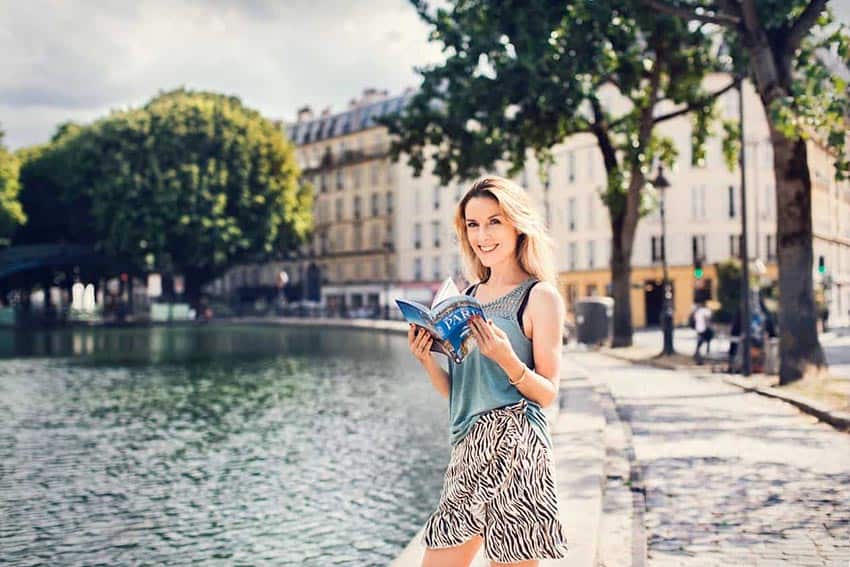
Gdansk: 80 Years After the First Shot of World War II
By Patti Morrow
It wasn’t the typical “see the view” tower that I’d climbed in so many other Central European cities.

Taking on the lofty turret in St. Mary’s church in Gdansk, Poland proved a worthy opponent. The massive 14th-century Gothic basilica is the largest brick ecclesiastical structure in the world, and the 400 timeworn spiral steps to the viewing platform were almost double the number I’d come to expect.
Top of the Church
Thighs burning, lungs heaving, sweat pouring, I persevered and reached the tiny terrace. I squeezed my way through the crush of people all vying for a prized Instagram spot at the edge of the platform.
Once there, just a fence separated me from the dizzying, nearly vertical drop.
The 360-degree view was worth the barely contained acrophobia – from the red-tiled roofs close enough to touch, the delicate light green spires and the deliberate Mannerist reconstructions just beyond, and the Motlawa River just visible on the horizon.
If I hadn’t seen the 80-year-old photos in person, I would have found it hard to believe. Gdansk was not just the place where World War II started, but it had been completely decimated by Nazi bombs.
Having traveled extensively throughout Central Europe, I expected the rebuilt city to have the look and vibe of the lovely-but-typical Austro-Hungarian architectural period.
What I found was both visually and viscerally different. Gdansk was colorful and whimsical with a dash of defiance – an invitation to explore further. The way in which the citizens of Gdansk hoisted themselves up from World War II and the subsequent Soviet oppression is nothing short of inspiring.

Westerplatte
I stepped onto the Spanish galleon with a bit of a giggle. The boat, appropriately named “the Black Pearl,” seemed more Caribbean pirate than historically European, but I’m always game for a little fun.

We launched from the dock on the Motlawa River and headed out into the Baltic Sea for the Westerlatte peninsula, sailing smoothly past the festive shops and bistros filled with tourists.
During the 30-minute cruise, Michat, our local guide, regaled us with Gdansk’s history, including the curious tug-of-war over its borders with German, Prussian, and Russian conquerors.
The Battle of Westerplatte, in the early hours of September 1, 1939, marked the start of World War II in Europe. Before the First World War, Westerplatte had been a resort with a beach, spa, and a park.
Westerplatte was attacked because in 1921 it had been established as the only Polish military presence in the predominantly German population living in Gdansk.
We walked around the small peninsula littered with ruins of former rudimentary bunkers, barracks, and guardhouses. An 82-foot tall granite monument was erected to honor Poland’s coastal defenders who bravely, but unsuccessfully, attempted to resist the invasion of the Third Reich during the seven-day encounter.
A sobering sign next to the monument reads “Nigdy Więcej Wojny” – War Never Again.
Old Town
I spent days happily wandering around the grid of old town streets. Craning my neck at the pastel tenement structures looming on either side of me, I marveled that this was the same cobblestone promenade, called “The Royal Way,” where Polish kings had tread centuries ago.

As I stopped at the 17th-century bronze Neptune Fountain, crowded with tourists, I was swept away by the sensation that Gdansk was still overwhelmingly Polish – the architecture, the street food, the hearty laughter and voices speaking Polish – and seldom visited by American tourists.
After the end of World War II, Gdansk rebuilt the city, but not as it had stood, in the Austro-Hungarian style of Central Europe; they restored the city to a former Mannerist style that had preexisted it. The pseudo-medieval buildings and spiky towers deliver a distinct fairytale allure.
The result is one of the most utterly charismatic city centers in Poland. For me, I don’t care that it’s not original (although so carefully designed and constructed that I’m sure it has fooled many); I am absolutely enamored by the Polish passive-aggressive defiance that thumbed its nose at the former German influence and dug back into a preferred time and architecture. Kudos!

Motlawa River
At sunset, I tore myself away from the old town. Striding through the four-arched gatehouse at the end of Dlugi Targ (the Long Market), I emerged onto the chaos of the river walk.
Gabled structures with flowers spilling over iron balconies line the sides of the waterway, reminiscent of Amsterdam or Copenhagen. It’s here that I got the iconic photo of Gdansk that I’d seen in glossy travel magazines.
The Motlawa River area is a foodie’s haven, lined with al fresco restaurants, bars, and food stalls selling fire-roasted sausages, pierogi, oscypek (fried smoky-flavored sheep cheese), and obwarzanek (a cross between a pretzel and a bagel).
I tried them all, then walked across the Green Bridge to an ice cream stand near the Amber Sky Ferris wheel and had that too.

Solidarity
Near the end of my stay, fuzzy memory of television news programming from the 1980s seeped into my consciousness. I was young, and not interested in politics, but Lech Wałęsa and his Solidarity movement changed the course of world history.
This year is not just the 80th anniversary of the beginning of World War II but also the 30th anniversary of when the Soviet Bloc’s first independent trade union, Solidarity, lead to the end to communist rule. The Solidarity movement began in Gdansk’s shipyards, and in 1989, it brought down communist rule over Poland.
I must confess, I did not venture into any of Gdansk’s excellent museums. I couldn’t bear to tear myself away from the outdoor ambiance of the quasi-old town, the vibrant panorama stretched out directly in front and in my peripheral vision, the exuberant voices of the Polish people when I closed my eyes, and the savory scent of garlic and onions assaulted my nostrils, leading me to yet another street vendor.
This is why I’d come to Poland. This is why Gdansk is now of my favorite European cities.
Best Hotels in Gdansk, from Culture Trip.com
Disclosure: The author was honored to be the guest of JayWay Travel during her stay in Poland, but as always, the opinions, reviews, and experiences are her own.

Patti Morrow is a freelance travel writer based in South Carolina with over 150 bylines in 35+ print and online publications, author of the book “Girls Go Solo: Tips for Women Traveling Alone,” and editor of the award-winning travel blog Luggage and Lipstick.
- Mongolia, the Land of Eternal Blue Sky - April 20, 2024
- These 9 U.S. National Parks Require Reservations in 2024 - April 17, 2024
- Take a Hike in Olympic National Park - April 17, 2024






You’re correct in the origin of the snack, but the author simply stated that Oscypek is for sale in Gdansk, as well as in other parts of Poland. Thank you for reading our story Hayley.
“Gdansk is known for oscypek, fried smoky-flavored sheep cheese snack.”
This is actually inaccurate, Oscypek is actully a regional speciality and its comes from Zakopane in the very South of Poland, to be officially called “Oscypek” it has to be made and produced in Zakopane as it is UNESCO protected.